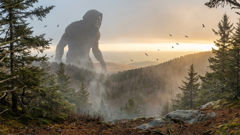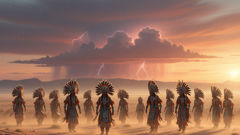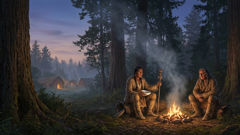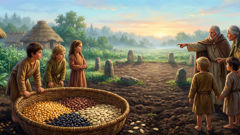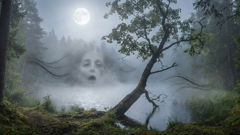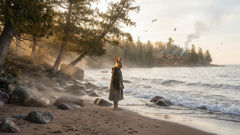Introduction
Beyond the roads and radio towers, above valleys that breathe fog into mornings, the highest ridges of the southern Appalachians keep memory like a private light. There, where the spruce and hemlock grow dense and the water finds its own slow, patient way, the name Tsul 'Kalu' is spoken as both warning and greeting. To hear it is to remember a time when tall figures cut silhouettes against the dawn, when footprints the size of small clearings pressed into the earth and rivers ran more cautious. Tsul 'Kalu' — sometimes called the slant-eyed giant, other times the mountain hunter — belongs to the old stories told by firelight beneath low, smoke-darkened rafters. The tales are not all the same; they knot together like roots, shifting with each telling, carrying lessons about respect, hunger, and what it costs to live where stone meets sky. This story aims to bring one thread of that living weave into the present: a retelling shaped by landscape, by the hush of wind through ridgeline pines, and by the belief that the mountain remembers those who listen carefully. Read gently. These are not prophecies but echoes, and they ask us to hear the giant's steps not as conquest, but as a measure of balance between people and the wild places they share.
Roots of Stone: Origins and the Mountain's Memory
In the long years before numbered maps, when canebrakes and chestnut groves filled the hollows and bears threaded the ridgelines with indifference, the people who later called themselves Cherokee told of beings who were older than the smoke of any hearth. Those tales did not arrive finished; they grew. Tsul 'Kalu', the slant-eyed giant, found shape in those stories because the mountains needed someone who could make them speak. He is a figure of edges: his eyes are said to slant not with malice but with the tilt of mountain slopes that favour certain streams; his gait moves weather into valleys; his lungs breathe out winter fog. His name is a key for certain doors in the woods—doors to caution and doors to counsel.

[Image: tsul-kalu-hunter-in-forest.webp]
The old people spoke of him as a hunter, and of the mountain as both his domain and his test. A hunter in a land that feeds by patient measure must be patient too. Tsul 'Kalu' tracked deer the way wind tracks clouds: with a grand, measured economy. He took what sustained him and left room for the earth to heal. In some tellings, he walked alone; in others, he had companions—wolf-thin shadows that would vanish when the light shifted. In winter tales he was a figure of appetite and endurance, a reminder that the seasons demand their dues.
The mountain stitched his name into place-names and story-paths. When a stream changed course after a rockfall, people said it was because Tsul 'Kalu' had shifted his weight. When an elk herd vanished from a ridge, they said it was because he had taught the herd to be more quiet. There was, in this, a kind of justice that felt neither petty nor friendly. The giant's justice was the slow, patient kind of the stones themselves: it rearranged consequences and left both the earth and the people altered in ways that took years to understand.
Stories of origin also carry warnings. One version passed along by elders tells of a time when a village took more than it thanked the mountain for. They cut old trees to expand gardens and built noisy iron traps to take game more quickly. The balance shifted. Streams ran muddier; berries came less often. The mountain answered by teaching through scarcity. Tsul 'Kalu' appeared as a silhouette on a ridge, larger than any man, his slanted eyes reflecting a hard, quiet light. He did not speak in that tale. He simply moved through the cleared space and stood at the edge of fields where children once ran. The children felt, without knowing why, that the fields were no longer certain and that the earth would have its say.
Not every telling paints Tsul 'Kalu' as hostile. Many portray him as a stern teacher. When a young hunter who did not know the patience of the mountains followed a wounded deer into fragile highland meadows, it was Tsul 'Kalu' who stepped between the hunter and the last of the herd. The giant's hands were huge enough to cup the boy's shoulders, and his slanting gaze taught restraint. After that meeting, the hunter learned to take only what would let the meadow breathe. The tale ends in the hollowing way of oral history: sometimes the hunter thanked the giant, sometimes he resented him, sometimes he told the story in a way that made himself braver. The mountain, discreet as the roots below, kept its own ledger and moved on.
There is an older thread that ties the giant to the idea of guardianship. Mountains in Cherokee thought are not empty inheritances; they hold spirits—kituĝi (house spirits) and other beings—who watch and sometimes judge. Tsul 'Kalu' is not a house spirit in every sense, but he shares their quality: he is human-shaped enough to be known, other-shaped enough to be feared. Some storytellers insist he is an ancient kin of the people, a giant relative who walked before the first smoke of human fires; others suggest he is a different kind of being altogether, a lesson embodied. Either way, the stories are less concerned with literal genealogy than with relational truth: how we live in the presence of forces larger than our choice-making. That lesson is enduring. It is a quiet insistence that the mountain has memory and that those who forget it do so at their peril.
Encounters and Lessons: People, Place, and the Giant's Measure
Encounters between Tsul 'Kalu' and people carry many lessons, some gentle as morning, others abrupt as a winter storm. The mountain demands a certain posture toward living things: to take only what will regenerate, to speak with humility, to listen for the subtle changes of weather and earth. In village stories, encounters often happen at thresholds—the mouth of a hunting path, the first step into a high meadow, or the moment a caravan of traders pauses beneath a ridge. These thresholds matter because they are places where two kinds of knowing meet: the domestic, human knowledge of fire and craft, and the deep, slow knowledge of stone and season.
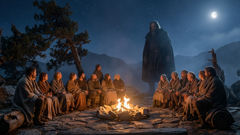
In one tale, a young woman named Elisi (a name given in the retelling to hold the human shape) loses her way during a forced migration when a drought turns trails into confusion. She climbs and climbs, hoping to find a particular ridge where a certain elder said blackberries always grew later than elsewhere. Instead she finds an enormous shadow blocking the pass, a figure whose shoulders make a horizon and whose voice, when it comes, is like tree trunks rubbing. Elisi does not scream; in the retelling she holds a steadiness born of elders' stories. The conversation that follows is peculiar because words are small next to such presence. Tsul 'Kalu' does not lecture. He listens, perhaps surprised that a person would seek blackberries while the world is changing. He points—not with a finger but with a shift of stance—toward an understory slope, where a trickle of water keeps a hidden cup of berries. Elisi learns to pick with restraint, to leave more than she takes, and to spread the knowledge of that slope to those who will steward it properly.
Not all tales are kindly. In a winter when hunters used snares that tangled more than they intended, and when friction among villagers ran high over the scarce meat, Tsul 'Kalu' is said to have taken a night to rearrange the traps into knots men could not untie. The story does not make him a moral arbiter with easy answers; instead he stands as a force that introduces consequence into a tangled web of human intent. The villagers wake to find their snares empty and their fires smaller, and the elders, who remember a time before snares, speak of balance and forgiveness. Some of these stories end with restitution: the village learns a hard humility, plants a grove of saplings on a ridge, and sings a new song to the mountain. Other variants keep the sting: people leave and never return, and the ridge becomes a place of careful silence.
What is striking about these encounters is how they teach a relational ethic rather than a list of dos and don'ts. Tsul 'Kalu' is not a lawmaker for the sake of order alone; he acts in the register of ecological reciprocity. In the language of the mountain, taking too much, speaking too loudly, or using the land as an endless store creates an imbalance that the deep places correct. The giant's corrections are not always gentle, yet they are purposeful: to restore an ecosystem's capacity to sustain life. Stories that survive the years are those in which humans learn to adapt—not by domination but by co-living. That, many elders say, is a survival story more than a moral one.
Encounters also carve human character. Hunters who met Tsul 'Kalu' and returned untouched often came back altered. They learned the economy of patience and the art of listening. Once a man named Yonah came back to his village with a chest full of trinkets and tales of cunning, having refused the giant's counsel. A winter later, when the fires curled lower than usual and cold pressed bones to thought, Yonah found his traps empty and his store of stories hollow. The retelling of his mistake becomes a cautionary parable: cleverness without regard for the mountain's measure is fragile. Conversely, those who learned to listen and replant the used patches of land found that meat returned and water tasted cleaner. These outcomes, repeated across tellings, teach that living in the shadow of something larger demands reciprocity.
The giant's slanted gaze is itself a teacher. Slanted eyes, storytellers suggest, edge the world into two perspectives at once—one that sees the surface shape and another that reads depth. To meet that gaze is to be invited into double vision: you see yourself and you see how your actions appear on the land. The great hunter is not only a taker; he is also an assessor, a living measure against which behavior is weighed. In many versions, children are the ones who truly understand this measure, because children still notice details adults have learned to ignore. A child might notice a certain bird's call missing from a dawn chorus, and when reported to elders, that small observation opens a chain of understanding about the health of a ridge. Tsul 'Kalu' becomes a narrative device to teach attentiveness: small things matter, and they accumulate.
Encounters extend beyond humans. Animals in the stories are actors with agency. Deer that elude hunters are sometimes said to have been taught evasive patterns by the giant. Wolves that once skirted human habitations later return as cautious neighbors, the balance shifting in slow cycles. Even the wind plays a role; the giant's passage is likened to a wind that reorders leaves and stacks small stones in new patterns. The world in these stories is alive and mutual: every taking has a trace and every giving leaves a mark. The result is a moral ecology expressed through narrative, where Tsul 'Kalu' is less a villain and more a calibrator, one who keeps a ledger that spans generations.
As these tales circulate, they adapt. Traders, settlers, and travelers carried shards of the stories to new places, where the giant met other characters—reformers, hunters with iron traps, and people who thought of land as ledger rather than home. In those cross-tellings, Tsul 'Kalu' sometimes becomes a symbol of resistance to rapacity: a towering figure who refuses the commodification of land. While such interpretations are modern overlays, they speak to the story's elasticity and to how community memory reshapes myth to answer present fears. Through centuries, the central thread holds: respect the land, listen with both ears, and understand that balance is a living practice, not a dogma.
Ultimately, the encounters with Tsul 'Kalu' teach humility. They instruct listeners to honor seasons, to sew seeds where soil needs it, and to let the mountain keep some places private. Some villages learned this and thrived; others forgot and paid the mountain's silent tax. The stories that remain richest are those that end in repair—where people plant trees, learn new hunting practices, and tell the tale of the giant so children will remember. That telling itself keeps balance: memory is a kind of stewardship. It ensures that the slant-eyed watcher stays not as a monster but as a guardian of a particular way of being—one that asks humans to be careful, to be humble, and to hear the quieter voices of the world.
Conclusion
The story of Tsul 'Kalu' is not a single fixed narrative but a living conversation between people and place. Each telling reshapes the giant's contours according to what a generation needs to remember. At its heart, the tale asks us to think in terms of reciprocity: what do we owe to the land that feeds us, what do we owe to our neighbors, and how do we leave the world for those who follow? Tsul 'Kalu' teaches by his presence and absence—sometimes stepping in to correct, sometimes standing at the horizon as a silent possibility. The slanted gaze is not an accusation but an invitation to look twice: to see immediate needs and the deeper patterns those needs fall into. In hearing the giant's footsteps echoed in ridgelines and riverbeds, we are reminded that living well in a place requires attention that outlasts short-sighted profit and easy violence. The mountain keeps a memory longer than we do; honoring it means learning patience, building practices that allow soil and stream to renew, and sharing stories that teach children to notice the small changes before they become disasters. This tale is an offering, not a claim of definitive knowledge. It asks readers to approach old stories with respect, to seek context from community, and to carry forward the kind of stewardship that keeps mountains singing for generations to come.

